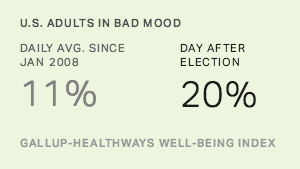Story Highlights
- Election Day and day after were among most stressful days since 2008
- Bad mood percentage spiked more on 2016 Election Day than prior two
- Recovery in Americans' mood consistent with prior elections
WASHINGTON, D.C. -- Election Day 2016 and the day after were two of the most stressful days on record since Gallup and Healthways began tracking Americans' mood in January 2008. On Nov. 8, 19% of U.S. adults were classified as being in a bad mood -- experiencing a lot of stress or worry without a lot of happiness and enjoyment. That metric rose to 20% on Nov. 9. Before Election Day 2016, the metric had reached 19% or higher only three times in nearly nine years. The 2016 Election Day and day after figures are much higher than the daily average of 11%.
| Bad mood | |||||||||||||||||||||||||||||||||||||||||||||||||||||||||||||||||||||||||||||||||||||||||||||||||||
|---|---|---|---|---|---|---|---|---|---|---|---|---|---|---|---|---|---|---|---|---|---|---|---|---|---|---|---|---|---|---|---|---|---|---|---|---|---|---|---|---|---|---|---|---|---|---|---|---|---|---|---|---|---|---|---|---|---|---|---|---|---|---|---|---|---|---|---|---|---|---|---|---|---|---|---|---|---|---|---|---|---|---|---|---|---|---|---|---|---|---|---|---|---|---|---|---|---|---|---|
| % | |||||||||||||||||||||||||||||||||||||||||||||||||||||||||||||||||||||||||||||||||||||||||||||||||||
| Nov 9, 2016 | 20 | ||||||||||||||||||||||||||||||||||||||||||||||||||||||||||||||||||||||||||||||||||||||||||||||||||
| Feb 11, 2014 | 20 | ||||||||||||||||||||||||||||||||||||||||||||||||||||||||||||||||||||||||||||||||||||||||||||||||||
| Jun 3, 2013 | 20 | ||||||||||||||||||||||||||||||||||||||||||||||||||||||||||||||||||||||||||||||||||||||||||||||||||
| Nov 8, 2016 | 19 | ||||||||||||||||||||||||||||||||||||||||||||||||||||||||||||||||||||||||||||||||||||||||||||||||||
| Feb 20, 2013 | 19 | ||||||||||||||||||||||||||||||||||||||||||||||||||||||||||||||||||||||||||||||||||||||||||||||||||
| Gallup-Healthways Well-Being Index | |||||||||||||||||||||||||||||||||||||||||||||||||||||||||||||||||||||||||||||||||||||||||||||||||||
These results are based on interviews with approximately 500 U.S. adults each day since 2013 and 1,000 adults from 2008 to 2012 as part of the Gallup-Healthways Well-Being Index. Interviewers read respondents a series of emotions and ask them to say whether they experienced each one "during a lot of the day yesterday." The "bad mood" metric is defined as the percentage of U.S. adults who, reflecting on the day before they were interviewed, say they experienced a lot of stress or worry and did not experience a lot of happiness and enjoyment.
Previous Gallup research shows that increases in self-reported daily stress or worry and declines in happiness and enjoyment coincide with negative events such as the Sandy Hook school massacre, economic turmoil, natural disasters and tax day. Americans' mood is also more negative during the workweek than on the weekend.
Bad Mood Increases More on Election Day 2016 Than in Previous Election Years
Being a high-stakes, high-drama event, Election Day typically fosters a relatively high level of stress and worry in the population. The percentage of U.S. adults in a bad mood increased on the day of the election in 2008 and 2012 -- as well as 2016 -- compared to the average for the seven days prior.
However, the jump in bad mood on Election Day in 2016 is larger than the increase seen in the previous two elections. Americans' bad mood on Election Day 2016 was nine percentage points higher than the average of the seven previous days. Election Day 2012 and 2008 had a six-point and three-point difference, respectively, compared with the average of the seven previous days.
| Seven days before election (avg.) | Election Day | Day after election | *Next seven days (avg.) | ||||||||||||||||||||||||||||||||||||||||||||||||||||||||||||||||||||||||||||||||||||||||||||||||
|---|---|---|---|---|---|---|---|---|---|---|---|---|---|---|---|---|---|---|---|---|---|---|---|---|---|---|---|---|---|---|---|---|---|---|---|---|---|---|---|---|---|---|---|---|---|---|---|---|---|---|---|---|---|---|---|---|---|---|---|---|---|---|---|---|---|---|---|---|---|---|---|---|---|---|---|---|---|---|---|---|---|---|---|---|---|---|---|---|---|---|---|---|---|---|---|---|---|---|---|
| % | % | % | % | ||||||||||||||||||||||||||||||||||||||||||||||||||||||||||||||||||||||||||||||||||||||||||||||||
| Nov 8, 2016 | 10 | 19 | 20 | 12 | |||||||||||||||||||||||||||||||||||||||||||||||||||||||||||||||||||||||||||||||||||||||||||||||
| Nov 6, 2012 | 10 | 16 | 15 | 12 | |||||||||||||||||||||||||||||||||||||||||||||||||||||||||||||||||||||||||||||||||||||||||||||||
| Nov 4, 2008 | 10 | 13 | 15 | 13 | |||||||||||||||||||||||||||||||||||||||||||||||||||||||||||||||||||||||||||||||||||||||||||||||
| *Average of seven days after the day following the election | |||||||||||||||||||||||||||||||||||||||||||||||||||||||||||||||||||||||||||||||||||||||||||||||||||
| Gallup-Healthways Well-Being Index | |||||||||||||||||||||||||||||||||||||||||||||||||||||||||||||||||||||||||||||||||||||||||||||||||||
In all three election years, Americans' bad mood generally held steady the day after the election.
While Americans' mood deteriorated much more than usual on Election Day 2016, it appears to be bouncing back just as quickly as it did in 2008 and 2012.
Implications
Americans' mood soured on Election Day, something that typically has happened in election years. But the drop in mood was significantly worse this Election Day than in previous presidential election years.
There are several potential explanations for the increase in bad mood on Election Day and the day after. Beyond the public being anxious about the outcome of a particularly heated campaign, President-elect Donald Trump's victory largely was unexpected. Gallup found that three in four Americans were surprised that Trump won. Most media outlets and polls were predicting that Hillary Clinton would win, leaving many of her supporters without time to mentally prepare for stress and worry that might accompany a Trump victory.
Unlike the previous two elections, the candidate who won the Electoral College and thus the election did not win the popular vote. This could have contributed to more Americans, particularly Clinton supporters, experiencing a bad mood.
In addition, Trump and Clinton were the most unfavorably evaluated candidates in Gallup's polling history, which could have led to more anxiety at the prospect of either candidate winning.
Since the election, Americans' mood has improved but has not yet returned to levels seen before the election -- as was the case in 2008 and 2012. Still, the improvement so far is notable given the bitterness of the campaign and the protests against Trump taking place in many cities. The ongoing recovery in mood since the election could be an encouraging sign that most Americans who felt stressed and worried by the outcome are no longer letting these concerns affect their day-to-day lives.
Trump's actions since the election may be driving the mood boost. Gallup recently reported that 51% of U.S. adults are more confident in Trump's ability to serve based on his actions and statements since the election.
Also, the rise in Americans' confidence in the economy and record highs in the stock market could be boosting the nation's mood.
If previous patterns hold true, Americans' mood should fully recover this week as many gather for Thanksgiving. Previous research shows that Americans' happiest days of the year fall on holidays.
Gallup and Healthways will continue to monitor the impact of the Trump administration's policies and actions on Americans' health and well-being more broadly in the months ahead.
These data are available in Gallup Analytics.
Survey Methods
Results are based on telephone interviews conducted Jan. 2, 2008, through Nov. 16, 2016, as part of the Gallup-Healthways Well-Being Index survey, with a random sample of approximately 500 adults per day, aged 18 and older, living in all 50 U.S. states and the District of Columbia. For results based on the total sample of national adults, the margin of sampling error is ±5 percentage points at the 95% confidence level.
Each sample of national adults includes a minimum quota of 60% cellphone respondents and 40% landline respondents, with additional minimum quotas by time zone within region. Landline and cellular telephone numbers are selected using random-digit-dial methods.
Learn more about how the Gallup-Healthways Well-Being Index works.


